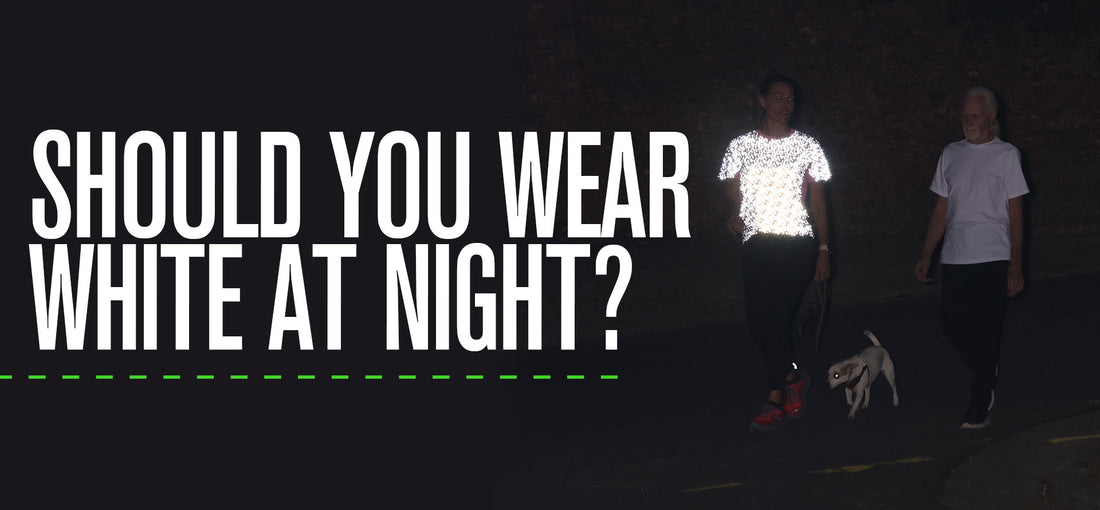We all want to stay safe when we’re walking, running or doing any other kind of exercise – and that can be especially challenging when we’re working out in the dark. We get a lot of questions like, “Is it safe to wear a white shirt when working out at night?” In this blog, we’ll attempt to answer that, as well as offer some other tips for keeping you safe when working out in low-light conditions.
Are White Shirts Safe For Nighttime Walking and Running?
The question about wearing white shirts for night walking (or white shirts or clothing for night running) doesn’t have a simple answer. While wearing white or other light-colored clothing while exercising can help with nighttime visibility and pedestrian safety, it’s not nearly as effective as wearing reflective clothing – and your clothing color and material is just one aspect to consider when practicing road safety at night. Read on for more…
What Are The Alternatives to White Clothing for Nighttime Running and Walking?
We’ll get into why white shirts for nighttime running safety aren’t sufficient, but first, let’s look at some better options. Basically, any good quality reflective running gear or high-visibility clothing is going to be a better choice for keeping you out of danger.
Here at WildSpark, we’re particularly proud of our line of reflective shirts for walking or running at night. We offer short sleeve reflective running shirts for night walking or running. For cooler weather, our long sleeve hi-vis shirts are a great choice. You can check out our full line of reflective shirts for walking and running at night here.
Why Aren’t White Shirts Safe For Night Walking and Running?
As we’ve mentioned, wearing a white shirt or a white sweatshirt is a better option than wearing a dark color on your nighttime run, but it is not sufficient for ensuring good light reflection on clothes while walking or running in low-light conditions. Here are seven reasons why:
Not Enough Contrast
While white shirts are certainly more visible than dark colors, they might not stand out enough against certain backgrounds, especially in urban environments with bright lights and reflective surfaces. This is one of the primary reasons we recommend wearing reflective or hi-vis clothing when you’re running or walking before dawn, at twilight, or after dusk.
Limited Coverage
A white or light-colored shirt might not provide enough coverage for you to be seen in the dark, especially if you’re wearing a jacket or other outer layers that aren’t reflective. Drivers may have a hard time seeing small patches of white amidst the surrounding darkness, so even in colder weather, you’ll want to make sure your outer layers are reflective or high-vis.
Poor Directional Visibility
A white shirt primarily provides visibility from the front and back of your body. Without reflective strips or other materials on your sides, it might be challenging for drivers approaching from the side to notice you. Good reflective or high visibility exercise clothing ensures that you can be seen from any angle.
Bad Weather Conditions
In fog, rain, or snow, visibility of pedestrians can be significantly reduced. A white shirt has a tendency to blend into mist, snow, or fog, making it difficult for others to see you clearly. Once again, reflective or high-vis clothing can overcome this issue, keeping you safe in any weather.
Inadequate Lighting
In poorly lit areas, the streetlights and ambient lighting might not be enough to illuminate you adequately, especially if you are wearing only a white shirt without reflective accessories. Reflective or high-vis clothing can help you stand out even in low-light conditions.
Running At Night Safety Tips (Pedestrian Safety Tips)
Now that we’ve established that wearing a white shirt isn’t quite enough to adequately protect you when you’re walking or running at night, let’s look at some other precautions you can take to keep you safe running at night – and safety tips for walkers, as well.
Choose The Right Gear
In addition to wearing reflective or high-vis shirts for your nighttime exercise, consider purchasing other accessories or gear. Reflective vests, armbands, and shoes with reflective elements can significantly improve your visibility, making it easier for drivers and others to spot you in low-light conditions. Additionally, using a flashlight or wearing a headlamp can help you see your surroundings better and alert others to your presence.
Plan Your Route Carefully
It’s a good idea to familiarize yourself with the area where you plan to run. Always know the well-lit streets, emergency phone locations if applicable, and safe spots where you can seek help if needed.
Always Run Against Traffic
If you have to run on the road, always run against the flow of traffic. This way, you can see approaching vehicles and react accordingly – and oncoming traffic has a better chance of seeing you.
Stay Aware Of Your Surroundings
Be vigilant and aware of your surroundings at all times. Make sure to stay off your phone and avoid other distractions so you can react quickly to any potential hazards.
Let Someone Know Where You’re Going
Always be sure to inform a friend, family member, or roommate about your running route and expected return time. This way, someone knows where to look for you in case of an emergency.
Carry Identification
It’s not pleasant to think of getting into an emergency situation when you’re just trying to get some exercise, but things happen. Carrying some form of identification, such as an ID bracelet or a card with your name, emergency contact, and any relevant medical information, can be a lifesaver if something goes wrong.
Avoid Isolated Areas
Especially if you’re out alone, you’ll want to stick to well-lit, populated areas on your run or walk. Joggers should try to avoid isolated or poorly lit places, parks, and trails at night.
Buddy Up
Speaking of being alone, it’s always best to have some company. Whenever possible, run with a buddy or join a group of runners. There's safety in numbers, and it can make your night jogging more enjoyable, too.
Trust Your Instincts
Finally, one of the biggest running at night precautions you can take is if something doesn't feel right, trust what your body is telling you and change your course or head to a more populated area. Our Spidey Sense can do an amazing job of keeping us out of trouble when we listen to it.READ MORE:
Safety Tips If You Are Cycling Or Biking At Night
Be Especially Careful If You Are Running In Hot Weather
Long Sleeve Hi-Vis Shirts For Night Walking
Short Sleeve Shirts For Night Walking

